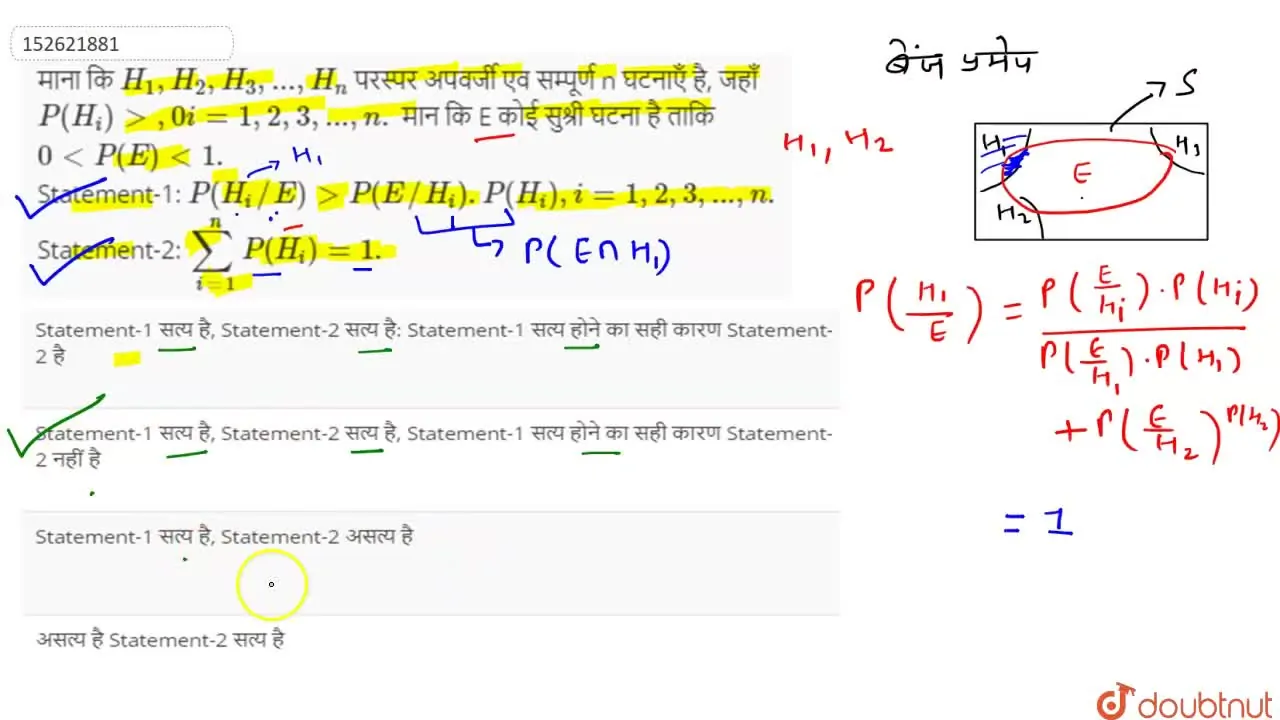माना कि H1,H2,H3,...,Hn परस्पर अपवर्जी एव सम्पूर्ण n घटनाएँ है, जहाँ P(Hi)>,0i=1,2,3,...,n. मान कि E कोई सुश्री घटना है ताकि 0<P(E)<1.
Statement-1: P(Hi/E)>P(E/Hi).P(Hi),i=1,2,3,...,n.
Statement-2: n∑i=1P(Hi)=1.
कथन-1 सही है, कथन-2 सही है, कथन-1 के लिए, कथन-2 का स्पष्टीकरण सही है।
कथन-1 सही है, कथन-2 सही है, कथन-1 के लिए, कथन-2 का स्पष्टीकरण सही नहीं है
कथन-1 सही है, कथन-2 गलत है
कथन-1 गलत है, कथन-2 सही है
The correct Answer is:B
Step by step video, text & image solution for माना कि H_(1), H_(2), H_(3), ..., H_(n) परस्पर अपवर्जी एव सम्पूर्ण n घटनाएँ है, जहाँ P(H_(i))gt,0i=1,2,3,...,n. मान कि E कोई सुश्री घटना है ताकि 0 lt P (E ) lt 1. Statement-1: P(H_(i) //E) gt P (E//H_(i)). P (H_(i)),i =1,2,3,...,n. Statement-2: sum_(i=1)^(n)P(H_(i))=1. by Maths experts to help you in doubts & scoring excellent marks in Class 12 exams.
Similar Questions
If H1,H2,H3,…..H2n+1 are in H.P then 2n∑i=1(−1)j(Hi+Hi+1Hi−Hi+1) is equal to
View SolutionList-I {:((P) H_(2)O gtgt H_(2)S lt H_(2)Se lt H_(2)Te,(1)"Bond angle"),((Q)H_(2)O lt H_(2)S lt H_(2)Se lt H_(2)Te, (2)"melting point and boilinng point"),((R )H_(2)O gt H_(2)S gt H_(2)Se gt H_(2)Te,(3)"acidity"):}
View SolutionThe following compounds are called electrons ( E^(+) ) In order of decreasing relative reactivity to (i) Chlorobenzene, 2-4-dinitrochlorobenzene, p-nitrochlorobenzene (ii) Toluene, p-H_(3)C-C_(6)H_(4)-NO_(2), p-O_(2)N-C_(6)H_(4)-NO_(2)
03:33View Solution{:("COLUMN-I","COLUMN-II"),((A)"Thermal stability",(p)H_(2)Te gt H_(2)Se gt H_(2)S gt H_(2)O),((B)"Acidic nature",(q)H_(2)O gt H_(2)S gt H_(2)Se gt H_(2)Te),((C )"Boiling points",(r )H_(2)S lt H_(2)Se lt H_(2)Te lt H_(2)O),((D) angleM MH " Bond angle",(s) H_(2)S gt H_(2)Se gt H_(2)Te=H_(2)Po):}
02:04View SolutionIf Hn=1+12+13+….+1n,∀n∈N, then H1+H2+H3+….+Hn=
View Solutionमाना H1,H2,….,Hn परस्पर अपवर्जी तथा निःशेष घटना , P(Hi)>0,i=1,2,…,n के साथ है। माना E एक दूसरी घटना 0<P(E)<1 के साथ है।
कथन-I : P(Hi∣E)>P(E∣Hi),P(Hi),i=1,2,…,n के लिए
क्योंकि
कथन-II : n∑i−1P(Hi)=102:21View SolutionLet H1,H2,...,Hn be mutually exclusive events with P(Hi)>0,i=1,2,..........n. Let E be any other event with 0<P(E) Statement I P(Hi∣E)>P(E∣Hi.P(Hi) for i=1,2,.......,n statement II n∑i=1P(Hi)=1
04:47View SolutionLet H_1, H_2, , H_n be mutually exclusive and exhaustive events with P(H_i)>0,i=1,2,...,n. Let E be any other event with 0 P(E|H_i .P(H_i) for i=1,2,.......,n statement II sum_(i=1)^n P(H_i)=1
04:14View Solution


